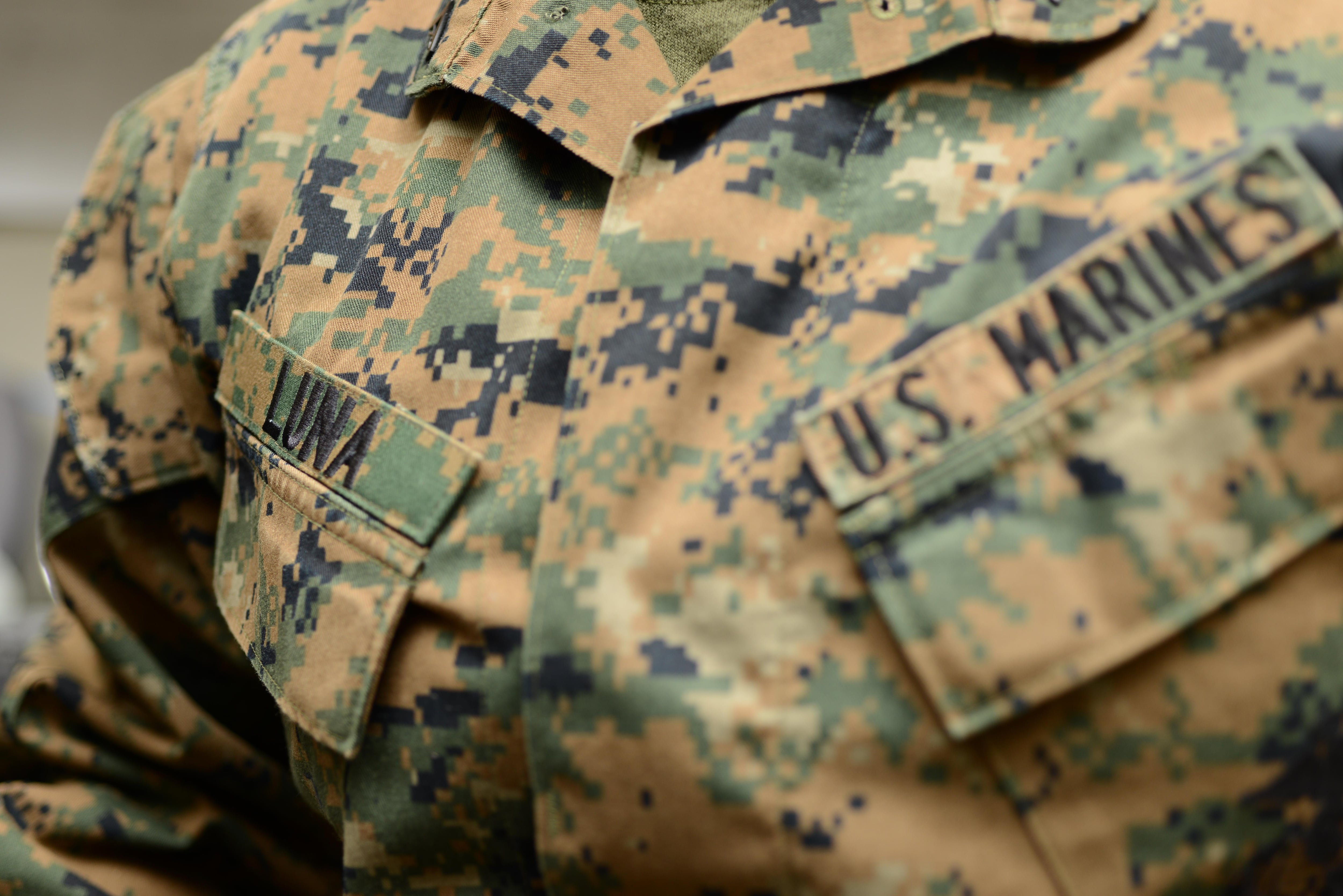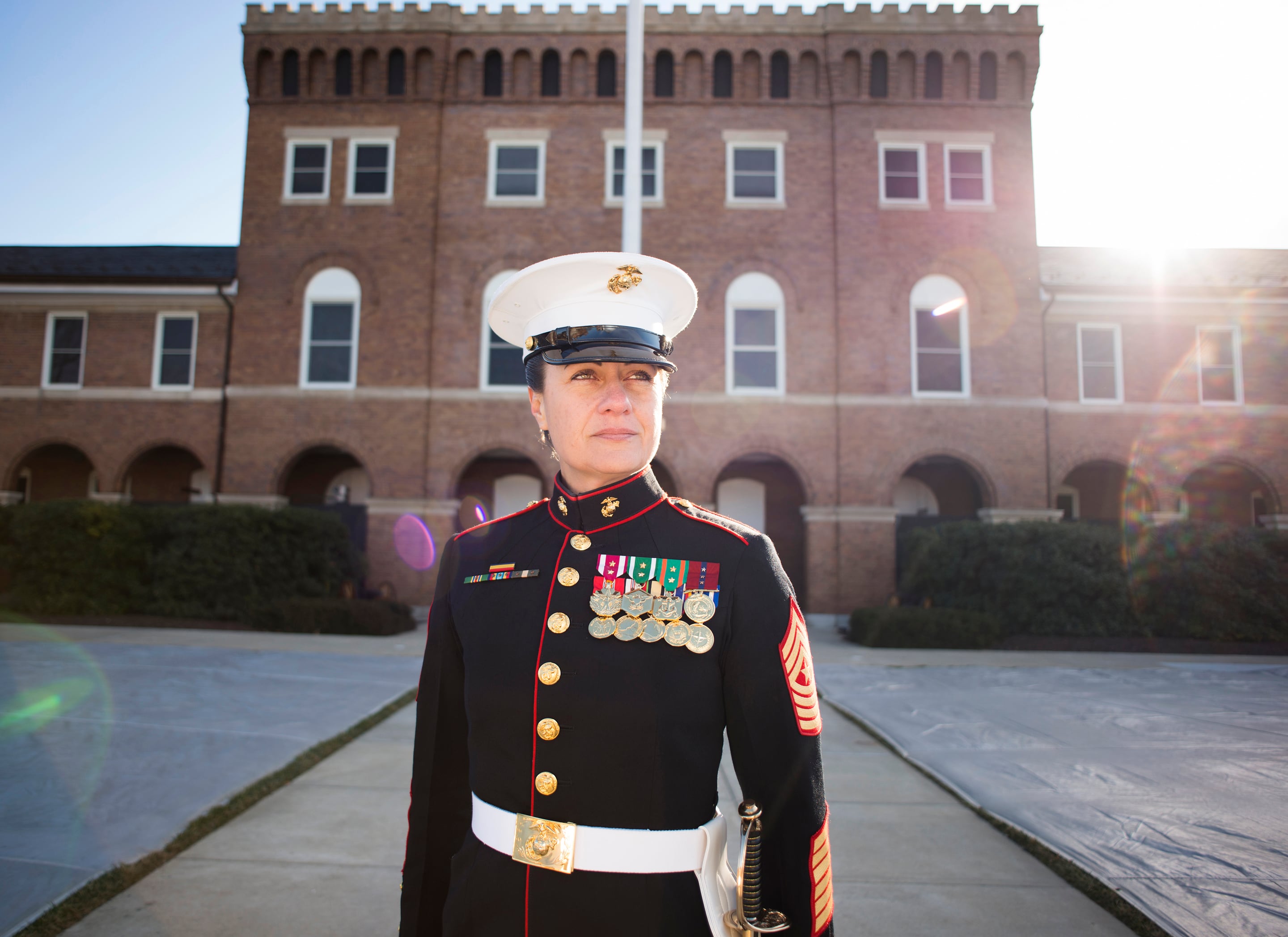Some Marines will no longer bounce between bounce back and forth from woodland and to desert cammies throughout the year, and all female Marines but will wear the camouflage appropriate for their location and mission. In addition, women Marines will soon wear a male-style dress the popular modified female blue dress coat that replaced the folded lapel with the iconic mandarin leatherneck collar.
These new rules changes were approved by Commandant Gen. Robert Neller and detailed Jan. 8 and included in Marine administrative message Marine Administrative Message011/16, which was released on Friday.
Marines will now wear the camouflage appropriate for their location and mission instead of rather than switching to a universal uniform on certain dates worldwide. And female Marines will adopt a modified version of a men's dress coat over the next few years.
Though not stated, the spirit of the message was clear: Marines are warriors, and their uniforms will reflect that. The changes are in In response to recommendations from Marine Corps Uniform Board No. 216.
One change that Marines will likely celebrate is Neller's decision to Commandant Gen. Robert Neller also shoot down a recommendation to make all devil dogs wear the service uniform when not in the field, while training or deployed. Neller The top Marine also axed an effort to remove desert camouflage uniforms delete the Desert MARPAT from Marines' the sea bag.
Here's a look at what Marines can expect.
Clime and uniforms
The change to the seasonal wear policy gives all Marine Forces commanders will now be able the ability to adjust seasonal uniform periods to accommodate climate and mission.

Commanders will now decide what types of camouflage uniforms their Marines wear based on local climate. That means Marines in Japan could wear woodland uniforms year round while those based in Twentynine Palms, Calif., could wear desert.
Photo Credit: Marine Corps
Officers Leaders with that authority include those who lead for Marine Corps bases, recruiting command, training and education command, security force regiment, and the embassy security group. This includes the commanding generals for Marine Corps Recruiting Command, Training and Education Command, Marine Corps Embassy Security Group, Marine Corps Security Force Regiment, and Marine Corps Bbases. A waiver database will be maintained on at the uniform board website, http://www.hqmc.marines.mil/Agencies/MarineCorpsUniformBoard.aspx.
The Corps said cCommanders should coordinate with other units in the immediate geographic area to achieve consistency in local seasonal uniform policy to "the extent possible given unique mission requirements," the MARADMIN states. Otherwise, the decision rests with the local commander.
The seasonal uniform, set in 2008, was meant to bring uniformity to Marines' appearance the Corps' look worldwide. Everyone wore desert camouflage utilities in the spring and summer, and woodland cammies in the fall and winter.
But Marines soon questioned the wisdom of wearing desert cammies in Okinawa, Japan, or woodland cammies in Twentynine Palms, California.
Unseasonably chilly weather in the National Capitol Region this past year also drove discussion. Marines in that region switched to the desert cammies with the rest of the service Corps in early March, but Headquarters Marine Corps granted a one-month delay on rolling sleeves up.
Universal dress blues
Changes for the female dress blues won't come as quickly as those for cammies.

The Marine Corps will adopt a modified version of the male dress blues coat for women, according to a new service-wide administrative message. Here, Sgt. Maj. Angela Maness wears a version of the coat during a wear test.
Photo Credit: Marine Corps
Women won't see the new dress blue coat for two to three years, officials said. Final tweaks must be made, then contracting and production timelines must be factored in.
The change comes after more than two years of tests and experiments that coincided with the Pentagon's push for gender-neutral physical standards and job opportunities. Navy Secretary Ray Mabus last summer said his goal is a collection of uniforms that "don't divide us as male or female, but rather unite us as sailors or Marines."
There were learning curves. For example, the Marine Corps did not provide guidance on ribbon placement for its new female dress blues, so wear testers used the spirit of existing rules to work out the issue as best they could.
Year-round service uniforms
While Neller nixed the recommendation to make the service uniform the norm, service bravos and charlies will remain the uniform of the day on Fridays.

Cpl. Christopher Croce's service uniform is inspected by an instructor during corporals course. The Marine service uniform will remain the uniform of the day on Fridays, but will not be required year round.
Photo Credit: Air Force photo
This rule was established in 2013 by then-Commandant Gen. James Amos in an effort to improve Marines' professional appearance and crack down on overweight troops taking advantage of the looser-fitting utility uniform.
The idea of moving to service uniforms year-round proved unpopular with Marines on social media. Many called the idea impractical and said it would raise Marine's monthly dry cleaning bills.





